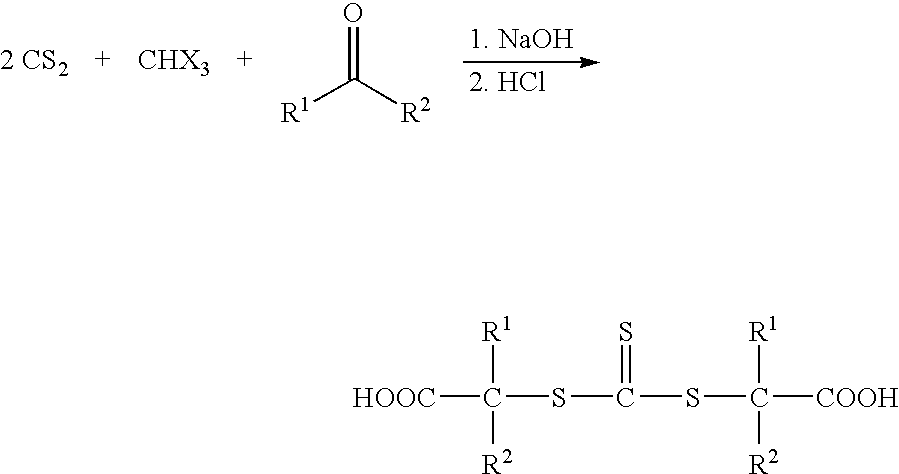S,S'-BIS-(alpha, alpha'-DISUBSTITUTED-alpha-ACETIC ACID)-TRITHIOCARBONATES AND DERIVATIVES AS INITIATOR-CHAIN TRANSFER AGENT-TERMINATOR FOR CONTROLLED RADICAL POLYMERIZATIONS AND THE PROCESS FOR MAKING THE SAME
a technology of initiator-chain transfer agent and terminal, which is applied in the field of s, s ′bis(, ′disubstituted ′′acetic acid)trithiocarbonates and derivatives thereof, can solve the problems of low conversion rate, strict reaction conditions, and living polymerization or the linking of end functional polymers
- Summary
- Abstract
- Description
- Claims
- Application Information
AI Technical Summary
Benefits of technology
Problems solved by technology
Method used
Image
Examples
example 1
Synthesis of s,s′-bis-(α, α′-disubstituted-α″-acetic acid)-trithiocarbonate, (R1=R2=CH3)
[0092]
Procedure:
[0093]In a 500 ml jacketed flask equipped with a mechanical stirrer, a thermometer, a reflux condenser and an addition funnel added 22.9 grams of carbon disulfide, 2.0 gram of tetrabutylammonium bisulfate and 100 ml toluene. The solution was stirred at 20° C. under nitrogen and 168 grams of 50% sodium hydroxide solution was added dropwise to keep the temperature between 20-30° C. 30 min. after the addition, a solution of 43.6 grams of acetone and 89.6 grams of chloroform was added at 20-30° C. The reaction was then stirred at 15-20° C. overnight. 500 ml water was added to the mixture, the layers were separated. The organic layer was discarded and the aqueous layer was acidified with concentrated HCl to precipitate the product as yellow solid. 50 ml toluene was added to stir with the mixture. Filtered and rinsed the solid with toluene to collect 22.5 grams of product after drying i...
example 2
Synthesis of s,s′-bis-(α, α′-disubstituted-α″-acetic acid)-trithiocarbonates. (R1=R2=CH3)
[0094]
[0095]The procedure was essentially the same as in example 1, except that mineral spirits replaced toluene as solvent. 40.3 grams of product was obtained as yellow solid.
example 3
Synthesis of s-alkyl-s-(-(α, α′-disubstituted-α″-acetic acid)-trithiocarbonates
[0096]
Procedure:
[0097]Dodecylmercaptan (0.1 mole), and Aliquot 336 (0.004 mole) was dissolved in 48 g acetone. 50% sodium hydroxide solution (0.105 mole) was added, followed by dropwise addition of carbon disufide (0-1 mole) in 10 g acetone solution. The media turned from colorless to yellow. After 20 min., cholorform (0.15 mole) was added followed by dropwise addition of 50% NaOH (0.5 mole) and 5 g NaOH beads. The r×n was stirred at 15-20° C. overnight, filtered and the sol. was rinsed with acetone. The acetone layer was concentrated to dryness. The mass was dissolved in water, acidified with concentrated HCl precipitate the product, rinsed with water to collect the yellow solid. The solid was dissolved in 350 ml hexanes. The solution was dried over magnesium sulfate and filtered. The organic solution was cooled to precipitate the product as yellow flakes. Yield is 85%.
PUM
| Property | Measurement | Unit |
|---|---|---|
| polydispersity | aaaaa | aaaaa |
| polydispersity | aaaaa | aaaaa |
| temperature | aaaaa | aaaaa |
Abstract
Description
Claims
Application Information
 Login to View More
Login to View More - R&D
- Intellectual Property
- Life Sciences
- Materials
- Tech Scout
- Unparalleled Data Quality
- Higher Quality Content
- 60% Fewer Hallucinations
Browse by: Latest US Patents, China's latest patents, Technical Efficacy Thesaurus, Application Domain, Technology Topic, Popular Technical Reports.
© 2025 PatSnap. All rights reserved.Legal|Privacy policy|Modern Slavery Act Transparency Statement|Sitemap|About US| Contact US: help@patsnap.com



